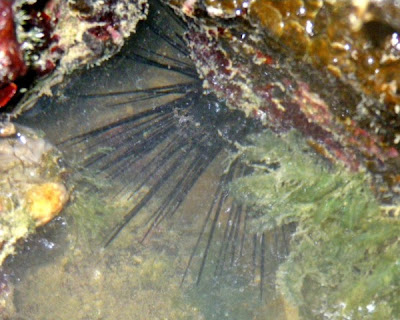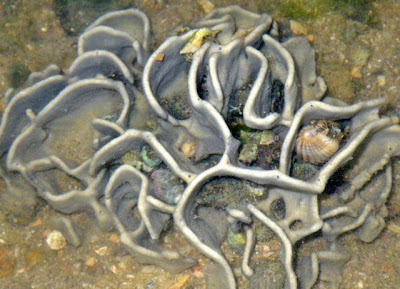We are back again at Tanah Merah. It's such a huge shore with different habitats at different areas. Therefore during this low tide season, the team is commited to cover as much grounds as possible.
Yes, there are certain stretches along the shore that is rather rocky with good growths of seaweeds among the rocks.
However, we headed to the sandy part when we first arrived. And shortly, Ria found this Horn-eyed ghost crab (Ocypode ceratophthalmus). feeding on a shrimp!
Unlike yesterday when I didn't see any peacock anemones (Order Ceriantharia), there were quite a number found today. This one is actually a juvenile.
While an adult peacock anemone looks like this.
Did you see this Elbow crab (Family Parthenopidae) in the photo above? It is well camouflaged and seems to be resting beside the peacock anemone.
At another peacock anemone, again one more elbow crab was spotted in the vicinity. Is there any relationship between the two? Hmmm...
Also not seen yesterdays are echinoderms like the Common sea star (Archaster typicus) that can be found abundantly on the sandy shore...
as well as the Cake sand dollars (Arachnoides placenta).
Chay Hoon later showed me another echinoderm and it turns out to be the Long-spine sea urchins (Diadema setosum). I think it's another first record for Tanah Merah. Well, this shore is surely big with lots of potential for more surprises.
Today wasn't as nudi-bulous as yesterday but it's always sweet to see this Polka-dot nudibranch (Jorunna funebris)- the only nudi spotted today.
I found the ever-elegant Persian carpet flatworm (Pseudobiceros bedfordi) today. We saw one yesterday but today's flatworm colour looks brighter.
This sponge which is probably Lamellodysidea herbacea has lots of hermit crabs hidden with the crevices. Quite cool!
Tanah Merah is home to lots of snails including the not so common Black-lipped conch (Strombus urceus). The Black-lipped conch is listed as 'Vulnerable' on the Red List of threatened animals of Singapore. It used to be abundant in the 1970s but is now uncommon.
James was on the lookout for the Haekel's anemone (Actinostephanus haekeli) today and he found the one spotted by Ria yesterday!
Another anemone that can also be found on this shore will be the Haddon's carpet anemones (Stichodactyla haddoni) where a pretty resident Five-spot anemone shrimp (Periclimenes brevicarpalis) can be found.
The best anemone find of the day must be this Fire anemone (Actinodendron sp.) by CH!
This anemone has about 16 fat fleshy tentacles with a thick base and tips covered with 'branches'. As its name suggest, they sting badly, so please avoid touching the fire anemone.
Squids are always a joy to have on the shores and they seem to be attracted to the light emitted from our torches. I also like the way they can change colours subtlely.
If you like marine fishes, Tanah Merah is the place to go!
There are many pretty fishes found by our team including this tiny juvenile Copperband butterflyfish (Chelmon rostratus).
Another orange-coloured juvenile fish found by James will be this Batfish (Family Ephippidae). I think this is my most favourite fish find of the day. I later found another one as well.
This stunning yellow banded fish which is unidentified seems to be inseparable from the long mangrove fruit that was floating in the waters. Yet another relationship that leaves me scratching my head. Nevertheless, it was cute!
Chay Hoon found a small school of Razorfishes (Family Centriscidae). Yes, also another first record for Tanah Merah. The fishes usually hangs head down in small synchronised groups. Their dorsal spine is long and sharp and located at the end of the body.
There was this intriuging find of a halfbeak that I've never seen before. It sure looks nice, especially near its tail.
More fishy finds includes this Slender seamoth (Pegasus volitans),
and this yet another unidentified beautiful small fish found by James. He names this as the flying fish and it seems to be able to leap around! Read more about his other fishy finds on his blog.
Towards the end of the trip, there was a patch with lots of Sand bubbler crab (Scopimera sp.).
Even the high shores can be interesting! There were a number of land hermit crabs (Coenobita sp.) that reside in dead snail's shells.
But the most interesting high-shore find will be this poor humungous jellyfish that was stranded. It sure attracted our attention.
Friday, August 7, 2009
Back to Tanah Merah
Subscribe to:
Post Comments (Atom)

































1 comment:
The yellow fish is probably a baby golden trevally (Gnathanodon speciosus). They're known to follow larger marine animals and also bits of floating rubbish as a form of defence against predators.
http://habitatnews.nus.edu.sg/guidebooks/marinefish/text/290.htm
Post a Comment